Letter from New York
24
November 2003.
Copyright ©2003 by
Mindy Aloff
Last Sunday
and Monday (November 16 and 17), the Works & Process series at the
Guggenheim Museum presented an evening dedicated to the reconstructions
of two “lost” Balanchine ballets—Le Baiser de la
Fée (1937, American Ballet; staged for the Ballet Russe de
Monte Carlo in 1940).) and Mozartiana (1945), both from Balanchine’s
years as resident choreographer for the Ballet Russe de Monte Carlo during
and just after World War II. The program was organized by The George Balanchine
Foundation, an archival organization that has devoted much of its considerable
energy to reconstructing and filming Balanchine ballets long out of rep,
as well as to filming original interpreters of familiar Balanchine roles,
many now much changed over time, in the act of coaching young dancers
from the point of view of what the first casts of Balanchine’s ballets
actually were directed to do.
read article
Revamped in Red
The Kennedy Center Opera House is Back in Action
Opera House Preview Performance
John F. Kennedy Center for the Performing Arts
Washington, DC
Wednesday, November 19, 2003
by George Jackson
copyright © 2003 by George Jackson
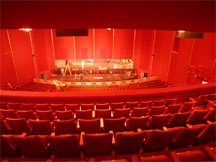 [The
Opera House at Kennedy Center closed for major refurbishing in December
2002. It reopened 11 months later for this performance, which Michael
Kaiser, the Center's president, referred to in his introductory remarks
as a "test". Kaiser said of the renovation that it was "nearly
completed", and he also emphasized that a major goal was to make
the Opera House more accessible. An organization for "promoting the
creative power in people with disabilities", VSA Arts, was co-presenter
with Kennedy Center of the three part program. ]
[The
Opera House at Kennedy Center closed for major refurbishing in December
2002. It reopened 11 months later for this performance, which Michael
Kaiser, the Center's president, referred to in his introductory remarks
as a "test". Kaiser said of the renovation that it was "nearly
completed", and he also emphasized that a major goal was to make
the Opera House more accessible. An organization for "promoting the
creative power in people with disabilities", VSA Arts, was co-presenter
with Kennedy Center of the three part program. ]
Thinking of the Kennedy Center's Opera House in its original guise, what
comes to mind first and foremost is red. It was a very red theater when
it opened in 1971 and neither time nor wear and tear altered that. The
red was medium in tone, and the cloths that bore the color covered walls,
ceiling, seats and floor. The stage curtain, on which a golden yellow
pattern seemed woven into the red background, looked texturally festive.
The other red fabrics didn't.
read article
Homage to St. Petersburg
St.
Petersburg in New York: Ballet
St. Petersburg Through American Eyes
Celebration of the 300th Anniversary of the City of St. Petersburg
The Harriman Institute of Columbia University
November 6-16, 2003
By
Dale Brauner
copyright © 2003 by Dale Brauner
St. Petersburg, Russia is to balletomanes what Wrigley Field is to baseball enthusiasts, Vienna is to music aficionados, and Rome is to Catholics. Many ballet lovers consider it the birthplace of the art form. St. Petersburg is the birthplace of George Balanchine, Anna Pavlova, Mikhail Fokine; the home of the Mariinsky Theatre and breeding ground to countless dance figures.
The city
observed its 300th anniversary this year and events celebrating the “Venice
of the North” are being held around the world. New York has the
largest population of Russians living outside Russia, so it is only right
that festivities have been staged here. The Harriman Institute of Columbia
University presented “St. Petersburg Through American Eyes; Celebrating
300 Years of St. Petersburg." held from November 6-16. There were
panels devoted to painting, music and literature, and also one devoted
to ballet (moderated by Lynn Garafola, Professor of Dance at Barnard College).
Participants were noted teacher Suki Schorer ("Transformed by America:
Balanchine and the Maryinsky Tradition"); author Tim Scholl (“The
Sleeping Beauty and St. Petersburg"); and critic Elizabeth
Kendall (“Passing on the Petersburg Legacy"), a session on
coaching with American Ballet Theatre principals Irina Dvorovenko and
Maxim Beloserkovsky.
read review
"Look at How Gypsy I am!"
Bailes
Ineditos
An evening of Flamenco
at the Jack Guidone Theater
Joy of Motion
Washington, D.C.
Saturday, 22nd November 2003
by Tehreema Mitha
coyright © 2003 by Tehreema Mitha
If you wanted an evening of quality entertainment this Saturday, you could have sauntered across to the modest Jack Guidone Theater at Friendship Heights, DC. The audience gathered there was in an excited expectant mood and the opening number to this evening of Flamenco dance did not disappoint.
Anna Menendez
and Edwin Aparicio make a handsome pair on stage. They meld well, equal
in their art, with a rapport that is so necessary to a coupling on stage.
Menendez comes to life the minute she takes up the traditional Flamenco
stance. Her arms become sinuous, strong yet effortlessly undulating, mesmerizing.
She is full of constrained sensuousness. Aparicio’s stance makes
the most of his packed frame. He dances as if born into this form, no
unintended tensions apparent in the structure of the torso.
read review
Reprinted from the Midweek edition:
SALVATION GOREYFIED
Riedel
Dance Theater
Joyce SoHo
New York, NY
November 20, 2003
by
Mary Cargill
copyright
© 2003 by Mary Cargill
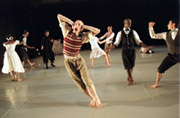 Jonathan
Riedel’s The Unsightful Nanny, based on Edward Gorey’s
work and performed as part of last years Limón season at the Joyce,
was one of the most unusual and mordantly funny works seen in sometime.
So the news that Riedel had formed a company formed mainly from Limón
dancers to present his own works, including a new Gorey piece, was exciting
news. His company (making its Joyce debut) is performing at the Joyce
Soho from November 20th through the 23rd.
Jonathan
Riedel’s The Unsightful Nanny, based on Edward Gorey’s
work and performed as part of last years Limón season at the Joyce,
was one of the most unusual and mordantly funny works seen in sometime.
So the news that Riedel had formed a company formed mainly from Limón
dancers to present his own works, including a new Gorey piece, was exciting
news. His company (making its Joyce debut) is performing at the Joyce
Soho from November 20th through the 23rd.
read review
EXTRA!
A Gala Opening, with Brilliant Dancing
Serenade/Bugaku/Symphony
in C
Gala, Balanchine 100: The Centennial Celebration
New York State Theater
New York, NY
November 25, 2003
by
Mindy Aloff
copyright ©2003 by Mindy Aloff
The news
is that the audience left this gala drunk on the performance of George
Balanchine’s Symphony in C, which, for the first time in
memories going back at least a decade, fielded four principal couples
who were more than adequate to their roles, a flock of demi-soloists who
danced with finesse and close attention to detail, and a superbly rehearsed
corps de ballet. Symphony in C—presented (with Concerto
Barocco and Orpheus) at the inaugural performance of the
New York City Ballet on October 11th, 1948—is debatably the cornerstone
of the New York City Ballet repertory: both a condensation and a summation
of Balanchine’s gifts and a monumental index to the full company’s
depth and range. A Karinska tutu ballet that, in this production, begins
with a squadron of 12 dancers at attention in fifth position and concludes
with a battalion of 50, photographically arrested at the crest of a rousing,
almost jazzily swinging march toward Georges Bizet’s top note, the
work stakes a powerful claim to just about every aspect of the classical
lexicon—adagio, allegro, jumps large and small, corkscrew turns
and smooth tours, transition steps and lifts—and, the ultimate program
closer, it wages what is debatably the most persuasive campaign on behalf
of classical dancing in the past 100 years. Even in uneven or indifferent
performances of it, the ballet advances toward a sense of triumph; it
is dancer-proof in that its individuals become subsumed in a larger whirlwind
of energy and choreographic design.
read review
Flying into the Unknown
Crossing,
Stories of Gravity and Transformation
Project Bandaloop
Eisenhower Theater
John F. Kennedy Center for the Performing Arts
Washington, D.C.
November 21, 2003
by Clare Croft
copyright
© 2003 by Clare Croft
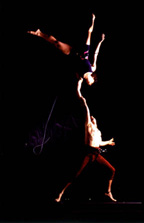 Until
Friday, I was an aerial dance virgin. After Friday, I am an aerial dance
enthusiast. On the West Coast, there are many dancers and choreographers
experimenting with hanging from ropes, but for the East Coast, Project
Bandaloop’s Crossing, Stories of Gravity and Transformation
was a welcome change of pace. Artistic Director Amelia Rudolph’s
piece part performance, part documentary featured dancers in the air and
on the ground. Projections from footage shot in the Sierra Nevadas, where
the company enacted eighteen days of site-specific work, appeared on a
giant trampoline that covered the back of the stage. Another trampoline
covered the stage’s left wings. The piece as a whole suffered from
a lack of cohesion, but when the choreography was beautiful, as it was
when the dancers took to the air, it was a revolutionary experience.
Until
Friday, I was an aerial dance virgin. After Friday, I am an aerial dance
enthusiast. On the West Coast, there are many dancers and choreographers
experimenting with hanging from ropes, but for the East Coast, Project
Bandaloop’s Crossing, Stories of Gravity and Transformation
was a welcome change of pace. Artistic Director Amelia Rudolph’s
piece part performance, part documentary featured dancers in the air and
on the ground. Projections from footage shot in the Sierra Nevadas, where
the company enacted eighteen days of site-specific work, appeared on a
giant trampoline that covered the back of the stage. Another trampoline
covered the stage’s left wings. The piece as a whole suffered from
a lack of cohesion, but when the choreography was beautiful, as it was
when the dancers took to the air, it was a revolutionary experience.
read review
Silken Illusions
15th
Anniversary Performance
LiliCai Chinese Dance Company
Yerba Buena Center for the Arts Theatre
San Francisco, California
November 15, 2003
by
Paul Parish
copyright © 2003 by Paul Parish
 The
most interesting part of the Lili Cai Chinese Dance Company's fifteenth
anniversary show last Saturday night was the series of stunning clips
in the video retrospective, which was screened just before the intermission.
The marvelous deep, high stage of the theater at the Yerba Buena Center
for the Arts downtown had just been filled with the snaking whorls of
traditional Chinese ribbon dancing, beautifully lit, which at moments
caught me up in complete fascination, watching the gorgeous silk reveal
the inner secrets of turbulent currents, but then left me wool-gathering,
reflecting (for example) on the possible debt of Loie Fuller to this form
of Chinese dancing. The three dances performed that evening were too similar.
In all of them, the dancers were there to make other things dance—you
followed the movements of cloth, or of flames, not the bodies of the dancers.
Which that night, for me, let me drift off into thought. But the clips
in the video arrested me, held me tight, impressed me repeatedly with
how strong the company is, how varied their repertory, how open they are
to new influences and how successful they are in collaborating with artists
from other cultures. I found myself wishing they were performing at least
one dance that was more rhythmic and embodied, like their award-winning
Common Ground (which they co-created with the African-heritage
Dimensions Dance Theater) and is strong, earthy, and grounded.
The
most interesting part of the Lili Cai Chinese Dance Company's fifteenth
anniversary show last Saturday night was the series of stunning clips
in the video retrospective, which was screened just before the intermission.
The marvelous deep, high stage of the theater at the Yerba Buena Center
for the Arts downtown had just been filled with the snaking whorls of
traditional Chinese ribbon dancing, beautifully lit, which at moments
caught me up in complete fascination, watching the gorgeous silk reveal
the inner secrets of turbulent currents, but then left me wool-gathering,
reflecting (for example) on the possible debt of Loie Fuller to this form
of Chinese dancing. The three dances performed that evening were too similar.
In all of them, the dancers were there to make other things dance—you
followed the movements of cloth, or of flames, not the bodies of the dancers.
Which that night, for me, let me drift off into thought. But the clips
in the video arrested me, held me tight, impressed me repeatedly with
how strong the company is, how varied their repertory, how open they are
to new influences and how successful they are in collaborating with artists
from other cultures. I found myself wishing they were performing at least
one dance that was more rhythmic and embodied, like their award-winning
Common Ground (which they co-created with the African-heritage
Dimensions Dance Theater) and is strong, earthy, and grounded.
read review
Deep Waters
Moon
Water
Cloud Gate Dance Theater of Taiwan
Brooklyn Academy of Music
Brooklyn, NY
November 20, 2003
By
Susan Reiter
copyright
© 2003 by Susan Reiter
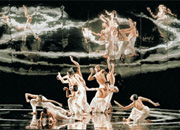 When
a theatrical experience is as mesmerizing and complete as Moon Water,
the latest work brought to these shores by Cloud Gate Dance Theater of
Taiwan, the afterglow resonates for days. The concept of creating a dance
work drawing primarily on the movements of tai chi could have led to something
insular—full of surface piety but distancing itself from an audience
rather than communicating to it. But Moon Water was the most
riveting 70 minutes I've experienced in a theater in a while, and the
immensely focused, amazingly concentrated audience at BAM suggested that
many were held equally rapt.
When
a theatrical experience is as mesmerizing and complete as Moon Water,
the latest work brought to these shores by Cloud Gate Dance Theater of
Taiwan, the afterglow resonates for days. The concept of creating a dance
work drawing primarily on the movements of tai chi could have led to something
insular—full of surface piety but distancing itself from an audience
rather than communicating to it. But Moon Water was the most
riveting 70 minutes I've experienced in a theater in a while, and the
immensely focused, amazingly concentrated audience at BAM suggested that
many were held equally rapt.
read article
Dionysian Screwball Comedy
This
is not a peep
Emspace and Bibliodance
Dance Mission Theatre
San Francisco, California
November 14, 2003
by Ann Murphy
copyright © 2003 by Ann Murphy
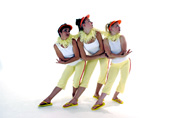 Since
coming on the scene as a dancer less than a decade ago, Erin Mei-Ling
Stuart has stood out. When she moves she looks silken, molten and boneless,
a mythical fish girl/woman, or a shapechanger who slips between the real
world and the archetypical, the human and the animal. Part of Stuart's
magic is that she projects a sexy emotional availability on stage that
flows out of a viscous physicality. She is an antidote to local artists
who have embraced dance like barbed wire, keeping out classical ideals
of beauty, musical structure and human relationship on the premise that
not only are those ideals suspect, if not politically bankrupt, but that
everything sucks, has always sucked and will always suck, no matter what
you do.
Since
coming on the scene as a dancer less than a decade ago, Erin Mei-Ling
Stuart has stood out. When she moves she looks silken, molten and boneless,
a mythical fish girl/woman, or a shapechanger who slips between the real
world and the archetypical, the human and the animal. Part of Stuart's
magic is that she projects a sexy emotional availability on stage that
flows out of a viscous physicality. She is an antidote to local artists
who have embraced dance like barbed wire, keeping out classical ideals
of beauty, musical structure and human relationship on the premise that
not only are those ideals suspect, if not politically bankrupt, but that
everything sucks, has always sucked and will always suck, no matter what
you do.
read review
|
|
|
|